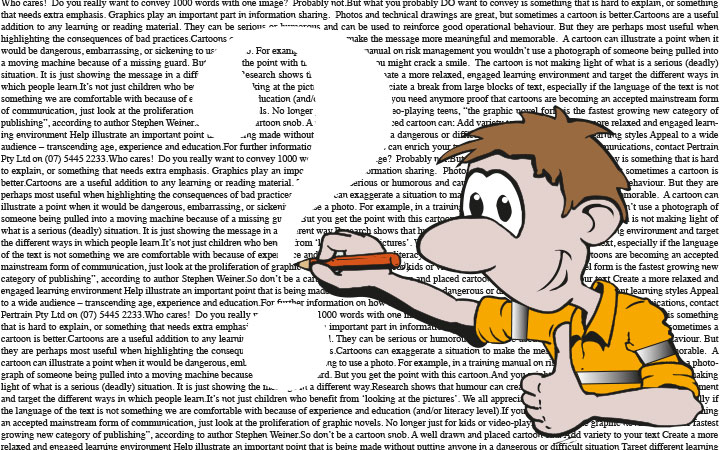Who cares! Do you really want to convey 1000 words with one image? Probably not.
But what you probably DO want to convey is something that is hard to explain, or something that needs extra emphasis. Graphics play an important part in information sharing. Photos and technical drawings are great, but sometimes a cartoon is better.
Cartoons are a useful addition to any learning or reading material. They can be serious or humorous and can be used to reinforce good operational behaviour. But they are perhaps most useful when highlighting the consequences of bad practices.
Cartoons can exaggerate a situation to make the message more meaningful and memorable. A cartoon can illustrate a point when it would be dangerous, embarrassing, or sickening to use a photo. For example, in a training manual on risk management you wouldn’t use a photograph of someone being pulled into a moving machine because of a missing guard. But you get the point with this cartoon.
And you might crack a smile. The cartoon is not making light of what is a serious (deadly) situation. It is just showing the message in a different way.
Research shows that humour can create a more relaxed, engaged learning environment and target the different ways in which people learn.
It’s not just children who benefit from ‘looking at the pictures’. We all appreciate a break from large blocks of text, especially if the language of the text is not something we are comfortable with because of experience and education (and/or literacy level).
If you need anymore proof that cartoons are becoming an accepted mainstream form of communication, just look at the proliferation of graphic novels. No longer just for kids or video-playing teens, “the graphic novel form is the fastest growing new category of publishing”, according to author Stephen Weiner.
So don’t be a cartoon snob. A well drawn and placed cartoon can:
- Add variety to your text
- Create a more relaxed and engaged learning environment
- Help illustrate an important point that is being made without putting anyone in a dangerous or difficult situation
- Target different learning styles
- Appeal to a wide audience – transcending age, experience and education.
For further information on how cartoons can enrich your training resources and corporate communications, contact Pertrain Pty Ltd on (07) 5445 2233.
Sources:
1. Alverson, B, 2013, Comics Book Resources: Graphic novel sales rise again in book market, http://robot6.comicbookresources.com/2013/10/comics-a-m-graphic-novel-sales-rise-again-in-book-market/
2. Barnicoat, B, 2012, The graphic novel’s spectacular rise: from kids’ comics to the Costa prize,
http://www.theguardian.com/books/2012/nov/23/graphic-novel-spectacular-rise-costa-prize
3. Shiyab, S. Pedagogical Effect of Humor on Teaching,
http://www.academia.edu/698395/Pedagogical_Effect_of_Humor_on_Teaching
4. Wanzer, M. 2012, Use of Humor in the Classroom, http://www.uab.edu/Communicationstudies/richmond_files/Richmond%20Humor%20in%20Classroom.pdf
5. Weiner, S. 2003, Faster Than a Speeding Bullet: The Rise of the Graphic Novel, http://www.uab.edu/Communicationstudies/richmond_files/Richmond%20Humor%20in%20Classroom.pdf


